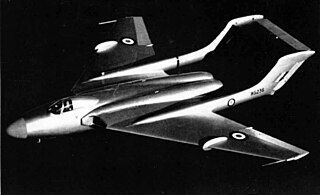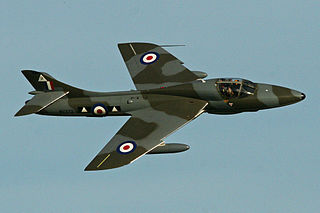History
De Havilland Aviation was born out of the former aviation trust, Jet Heritage (founded by display pilot Michael Carlton), although the De Havilland name has its roots much further back to the de Havilland Aircraft Company who built many of the aircraft that De Havilland Aviation eventually maintained. Originally set up by Gwynn Jones, the then owner of the Sea Vixen, it expanded its operation to the restoration and operation of other manufacturers and types of aircraft including Vampires, Meteors, and Hunters.
The Sea Vixen project was started in 1997 and took five years to complete during which time the First Sea Lord of the Royal Navy gave his support to the project. Following the completion of the project, XP924 was registered on the civilian register as G-CVIX and became the only flightworthy Sea Vixen in the World. The company was subsequently awarded a sponsorship deal by Red Bull Marketing to display the Sea Vixen in the Red Bull corporate logo. However, in 2007 the aircraft was restored to its former Navy markings, complete with its original registration of XP924. At the time, it was the only privately owned former military jet in Europe capable of breaking the sound barrier.
Following on from the success of the Sea Vixen project, the company embarked on providing support for many air show events around both the UK and Europe by way of aircraft displays and maintenance support. In August 2006, the company applied to the CAA to hold an air show operator's licence so that the Sea Vixen could be displayed along Bournemouth Seafront prior to the annual display by the Royal Air Force Aerobatic Team, The Red Arrows. As a result of that display and that of the Red Arrows, a charity lunch held at the Bournemouth BIC raised over £25,000 for local charities.
2005 Corporate buy out
In October 2005, the company was sold to a consortium led by Geoff Beck and Julian Jones, along with the aircraft stock. Paul Kingsbury, the Chief Engineer since the Jet Heritage days, took on the role of Director of Engineering and led the engineering side of the company. The role of Chief Pilot was continued by Brian Grant, a display pilot, until his retirement in December 2007. During his time as Chief Pilot for the company, Brian won the UK Airshow Review (UKAR) Classic Jet Display award for three years running for his public displays of the Sea Vixen. That award had never before been awarded three years consecutively to any display pilot or team.
De Havilland Aviation continued to restore and maintain classic jets, and provide operational support for air shows. It became a major sponsor of the inaugural Bournemouth Air Festival in 2008, having committed aircraft and logistical support to the four-day event. This included providing a De Havilland Venom as a static display at St. Paul's roundabout in Bournemouth to promote the event.
Its most recent project was the restoration to flight of former Red Arrows Folland Gnat XR537, having completed projects on two Jet Provosts during 2007. XR537 was officially re-launched during the Bournemouth Air Festival 2008 and was part of a nostalgic flypast with the Royal Air Force Aerobatic Team, The Red Arrows. That flypast remains the only occasion that a genuine former Red Arrows Gnat has flown in formation with the team's current BAe Hawks.
In May 2008, the company was contracted to take on the restoration of the former Source Aviation Flight, which included de Havilland Vampires and Venoms, and to return as many jets from that historic collection to flight as possible.

The Red Arrows, officially known as the Royal Air Force Aerobatic Team, is the aerobatics display team of the Royal Air Force based at RAF Waddington. The team was formed in late 1964 as an all-RAF team, replacing a number of unofficial teams that had been sponsored by RAF commands.

Hawker Siddeley was a group of British manufacturing companies engaged in aircraft production. Hawker Siddeley combined the legacies of several British aircraft manufacturers, emerging through a series of mergers and acquisitions as one of only two such major British companies in the 1960s. In 1977, Hawker Siddeley became a founding component of the nationalised British Aerospace (BAe). Hawker Siddeley also operated in other industrial markets, such as locomotive building and diesel engine manufacture. The company was once a constituent of the FTSE 100 Index.

The de Havilland Vampire is a British jet fighter which was developed and manufactured by the de Havilland Aircraft Company. It was the second jet fighter to be operated by the RAF, after the Gloster Meteor, and the first to be powered by a single jet engine.

The Folland Gnat is a British compact swept-wing subsonic fighter aircraft that was developed and produced by Folland Aircraft. Envisioned as an affordable light fighter in contrast to the rising cost and size of typical combat aircraft, it was procured as a trainer aircraft for the Royal Air Force (RAF) as well as by export customers, who used the Gnat in both combat and training capacities.

The British Aerospace 125 is a twinjet mid-size business jet. Originally developed by de Havilland and initially designated as the DH.125 Jet Dragon, it entered production as the Hawker Siddeley HS.125, which was the designation used until 1977. Later on, more recent variants of the type were marketed as the Hawker 800.

The de Havilland DH.110 Sea Vixen is a British twin-engine, twin boom-tailed, two-seat, carrier-based fleet air-defence fighter flown by the Royal Navy's Fleet Air Arm during the 1950s through to the early 1970s. The Sea Vixen was designed by the de Havilland Aircraft Company during the late 1940s at its Hatfield aircraft factory in Hertfordshire, developed from the company's earlier first generation jet fighters. It was later called the Hawker Siddeley Sea Vixen after de Havilland was absorbed by the Hawker Siddeley Corporation in 1960.

The Farnborough Airshow, officially the Farnborough International Airshow, is a trade exhibition for the aerospace and defence industries, where civilian and military aircraft are demonstrated to potential customers and investors. Since its first show in 1948, Farnborough has seen the debut of many famous planes, including the Vickers VC10, Concorde, the Eurofighter, the Airbus A380, and the Lockheed Martin F-35 Lightning II. At the 1958 show, the RAF's Black Arrows executed a 22-plane formation loop, setting a world record.

A warbird is any vintage military aircraft now operated by civilian organizations and individuals, or in some instances, by historic arms of military forces, such as the Battle of Britain Memorial Flight, the RAAF Museum Historic Flight, or the South African Air Force Museum Historic Flight.

The BAC Jet Provost is a British jet trainer aircraft that was in use with the Royal Air Force (RAF) from 1955 to 1993. It was originally developed by Hunting Percival from the earlier piston engine-powered Percival Provost basic trainer, and later produced by the British Aircraft Corporation (BAC). In addition to the multiple RAF orders, the Jet Provost, sometimes with light armament, was exported to many air forces worldwide. The design was also further developed into a more heavily armed ground attack variant under the name BAC Strikemaster.

The Royal International Air Tattoo (RIAT) is the world's largest military air show, held annually over the third weekend in July, usually at RAF Fairford in Gloucestershire, England in support of The Royal Air Force Charitable Trust. The show typically attracts a total of 150,000 to 160,000 spectators over the weekend.

The Fleet Air Arm Museum is devoted to the history of British naval aviation. It has an extensive collection of military and civilian aircraft, aero engines, models of aircraft and Royal Navy ships, and paintings and drawings related to naval aviation. It is located on RNAS Yeovilton airfield, and the museum has viewing areas where visitors can watch military aircraft take off and land. At the entrance to the museum are anchors from HMS Ark Royal and HMS Eagle, fleet carriers which served the Royal Navy until the 1970s. It is located 7 miles (11 km) north of Yeovil, and 40 miles (64 km) south of Bristol.

Llanbedr Airport, formerly RAE Llanbedr, is an operational general aviation airport located in the Snowdonia National Park near the village of Llanbedr, Gwynedd, northwest Wales.

A flypast is a ceremonial or honorific flight by an aircraft or group of aircraft. The term flypast is used in the United Kingdom and the Commonwealth. In the United States, the terms flyover and flyby are used.

Raynham George Hanna, was a New Zealand-born fighter pilot who emigrated to England to join the Royal Air Force (RAF). During his RAF career he was a founding member of its Red Arrows aerobatics display team. He also founded The Old Flying Machine Company, which commercially flies Second World War vintage fighter aircraft at air displays around the world, and for television and cinematic productions. He was a Spitfire display pilot in the latter half of the 20th century, noted for his daring aerobatic stunt flying.

On 6 September 1952, a prototype de Havilland DH.110 jet fighter crashed during an aerial display at the Farnborough Airshow in Hampshire, England. The jet disintegrated mid-air during an aerobatic manoeuvre, causing the death of pilot John Derry and onboard flight test observer Anthony Richards. Debris from the aircraft fell onto a crowd of spectators, killing 29 people and injuring 60.

Royal Air Force Tarrant Rushton or more simply RAF Tarrant Rushton is a former Royal Air Force station near the village of Tarrant Rushton east of Blandford Forum in Dorset, England from 1943 to 1947. It was used for glider operations during World War II and later revived for civilian operations. It is currently disused, though some buildings survive. Today it serves as a visual reference point (VRP) for VFR flights, in particular NW departures from Bournemouth Airport.

Simon’s Sircus was an aerobatics display team comprising six Sea Vixen FAW2 aircraft from 892 Naval Air Squadron of the British Royal Navy's Fleet Air Arm. The team operated during the summer of 1968 and was named after 892 Squadron’s commanding officer at the time, Lt Cdr Simon Idiens RN.

On 22 August 2015, a former military aircraft crashed onto a main road during an aerial display at the Shoreham Airshow at Shoreham Airport, England, killing 11 people and injuring 16 others. It was the deadliest air show accident in the United Kingdom since the 1952 Farnborough Airshow crash, which had killed 31 people.


















